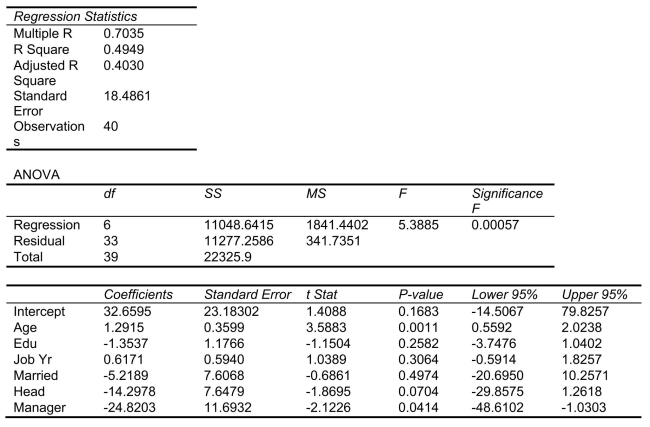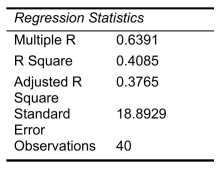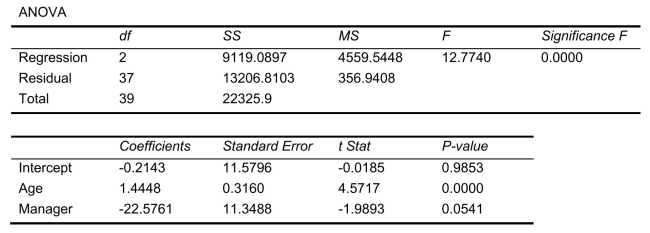SCENARIO 18-10 Given below are results from the regression analysis where the dependent variable is the number of weeks a worker is unemployed due to a layoff (Unemploy)and the independent variables are the age of the worker (Age), the number of years of education received (Edu), the number of years at the previous job (Job Yr), a dummy variable for marital status (Married: 1 = married, 0 = otherwise), a dummy variable for head of household (Head: 1 = yes, 0 = no)and a dummy variable for management position (Manager: 1 = yes, 0 = no).We shall call this Model 1.The coefficient of partial determination  of each of the 6 predictors are, respectively, 0.2807, 0.0386, 0.0317, 0.0141, 0.0958, and 0.1201.
of each of the 6 predictors are, respectively, 0.2807, 0.0386, 0.0317, 0.0141, 0.0958, and 0.1201.  Model 2 is the regression analysis where the dependent variable is Unemploy and the independent variables are Age and Manager.The results of the regression analysis are given below:
Model 2 is the regression analysis where the dependent variable is Unemploy and the independent variables are Age and Manager.The results of the regression analysis are given below: 

-Referring to Scenario 18-10 Model 1, we can conclude that, holding constant the effect of the other independent variables, the number of years of education received has no impact on the mean number of weeks a worker is unemployed due to a layoff at a 10% level of significance if all we have is the information on the 95% confidence interval estimate for  .
.
Definitions:
Null Hypothesis
The presumption that there is no significant difference or effect, often used as a default hypothesis in statistical testing that the experiment aims to reject.
Alternative Hypotheses
The hypothesis that proposes there is a statistically significant difference between two parameters or that a particular parameter is significantly different from a hypothesized value.
Type II Error
The error made when failing to reject a false null hypothesis, often referred to as a "false negative".
Null Hypothesis
A statement used in statistical testing which proposes that no significant difference or effect exists between certain characteristics of a population.
Q13: Referring to Scenario 20-1, if the probability
Q35: The logistic regression equation predicts:<br>A)The probability of
Q38: Referring to Scenario 17-4, the highest mean
Q40: Referring to Scenario 16-11, based on the
Q44: Referring to Scenario 18-10 Model 1, which
Q53: Referring to Scenario 16-6, the forecast for
Q97: Successful implementation of a regression tree requires
Q105: Referring to Scenario 18-5, the regression sum
Q123: Referring to Scenario 20-6, the optimal strategy
Q162: Referring to Scenario 19-6, a p control